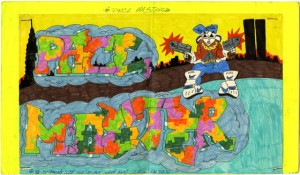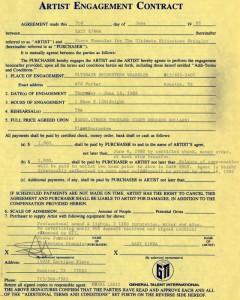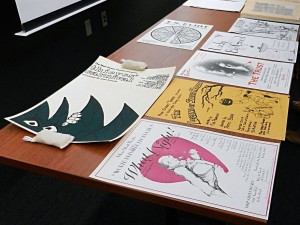
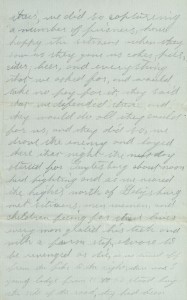
“… as we neared the heights north of Gettysburg met civilians, men, women, and children fleeing for their lives, every man grated his teeth and… swore to be revenged or die…” (detail from William W. Edgerton’s Gettysburg diaries)
The hits just keep on coming over at the University of Houston Digital Library with last week’s publication of the Civil War Letters digital collection.
With the flurry of additional items added to existing collections along with new collections going live over at the Digital Library, you may have just missed some of the new ground being broken for military historians or those with perhaps just a passing interest in Civil War history.
Combined from the M.L. Calk Civil War Letters, the W.D. Lowther Civil War Letters, and the earliest accessioned collection in our Military History collections, the William W. Edgerton Civil War Letters, this digital collection pulls together multiple sources providing researchers with a new view of these artifacts as well as new tools to answer that gnawing question of, “Where?”
When the location of a letter’s origin is known, a new map component accompanying this collection allows us to identify visually where the letter was written. We think Civil War buffs will appreciate this new functionality and the potential for future researchers, in this collection or those to come, is immediate and sure to be invaluable for those whose research interests are pinned to particular regions or desire to visually explore artifacts by locale.
Included among these digital items are letters belonging to both Confederate soldiers (Calk and Lowther) as well as correspondence from the Union side of the conflict (Edgerton). Quiet moments of correspondence cutting through the cacophony of warfare have long been prized by researchers as rich veins of information and insight. The correspondence of these brothers in arms is no different, offering personal views throughout.
Examples include bits like Lowther relating to his fiance, Phronie, the ordeal of a six day march or Edgerton’s writings allowing us a look into his diaries from the Battle of Gettysburg. M.L. Calk on the other hand, who served with the 23rd Alabama Volunteer Infantry Regiment, writes home to his mother from Vicksburg, Mississippi in February 1863 as he attempts to ease her mind, assuring her that he does not think he will have to fight, certain there will be “peace before long,” as the Yankees are “laying their army down and [swear] they won’t fight any longer for Lincoln. They have white men under Negro Colonels, and they say they can’t stand that…”
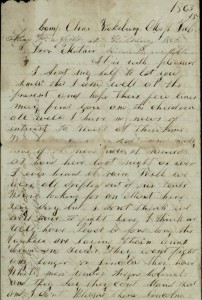
“… I don’t think we will have to fight here. I think we will have peace before long…” (from M.L. Calk’s letter home, prior to the Siege of Vicksburg)
Later, Calk would write to his sister, as the noose of General Ulysses S. Grant’s siege of Vicksburg tightened in May, that he “saw many fall and heard many crys and groans of the dying and wounded,” but counts his blessings as “the Lord was good and merciful… even a ball did not touch [his] clothes though they were flying as thick as hail all around… and many fell on every side.” Following the Union’s victory at Vicksburg, along with Robert E. Lee’s defeat at Gettysburg, Calk mustered out in July 1863. A map on the collection’s homepage, peppered with various colored dots from the Midwest, through the Tennessee Valley, stretching both north and south, illustrates the far-reaching impact of a war that threatened to permanently tear a nation asunder.
Spend some time exploring this new, rich, and interactive collection. But, if the digital collection has simply served as an apéritif, we invite you to come experience these original materials in the Special Collections Reading Room.
The University of Houston Special Collections is excited to announce that findings aids are now available for the DJ Steve Fournier Papers and the Carlos “DJ Styles” Garza Papers. These two new additions to the Houston Hip Hop Collections provide a glimpse into the early days of hip hop in Houston through the work of two pioneering DJs.
Steve Fournier DJed at prominent Houston clubs like Struts Disco, the Boneshaker, and the Rhinestone Wrangler throughout the 1980s and 1990s, steadily adding more and more hip hop to his mixes and helping to organize live rap performances. He also founded the Rap Pool of America in 1985, which eventually became the largest rap record pool in the country, sending out the latest hip hop albums to over 200 member DJs. His collection contains documents, photographs, publications, and memorabilia relating to his work. Of particular note is the Rap Performer Contracts series, which contains performance contracts for several prominent rappers, including Eazy-E, N.W.A., Sir Mix-A-Lot, Public Enemy, and Ice-T.
Carlos “DJ Styles” started out as a break dancer with the group The Dynamic Crew, performing under the name DJ Pace Master. Shortly thereafter he began DJing under the name DJ Styles, and eventually became a successful hip hop music producer, working with artists like The Odd Squad, Devin the Dude, and the Coughee Brothaz. He continues producing, mixing, and mastering hip hop music to this day. This collection includes personal records, fliers, posters, photographs, business records, audiocassettes, and memorabilia from throughout his career. My personal favorites are the hand-drawn fliers from his early days break dancing with The Dynamic Crew.
Both of these collections are worth a look, so browse through the finding aids and then stop by and visit us at Special Collections!
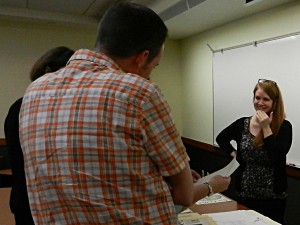
Houston Arts and History Archives Fellow, Stacey Lavender (far right), showcases items from the Main Street Theater Records at last week’s Brown Bag event
Last week Stacey Lavender, Houston Arts and History Archives Fellow for the University of Houston Special Collections, continued our Brown Bag Series by hosting the UH Libraries’ faculty and staff in an up close and personal look at the recently processed Main Street Theater Records. The Main Street Theater Records, filled with materials related to productions throughout its history, fundraising activities, and so much more, provide a telling view behind the curtain of Houston’s theater community and trace the evolution of Main Street from those heady, upstart days of the 1970s to the new century which sees Main Street and its multiple stages as an essential pillar in Houston theater.
In her presentation of the materials, Ms. Lavender highlighted the history of Main Street Theater, the role it has played in developing artistic talent, and the relatively unheralded but significant work done in the areas of education and outreach with the city’s youth. Following the presentation attendees participated in a Q&A, touching upon the challenges and rewards experienced in processing the collection, the delicate balance between access and privacy, the exciting possibilities of Main Street Theater as a living collection, and its potential for future research. Attendees were also given an opportunity to view and peruse items from the collection including production posters, newspaper clippings, photographs, and children’s fan mail addressed to Main Street, all culled by Ms. Lavender to highlight some of the treasures the collection holds.
If you are interested in getting your own up close and personal look at Main Street Theater, or perhaps any of our other Performing Arts collections, do come visit us at your earliest convenience.
